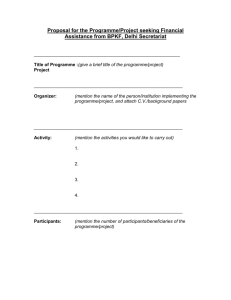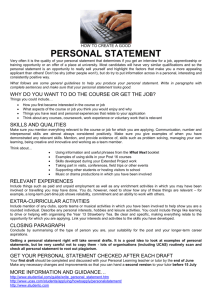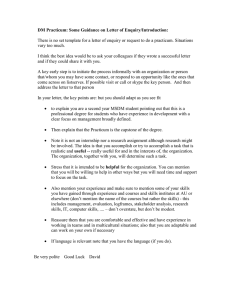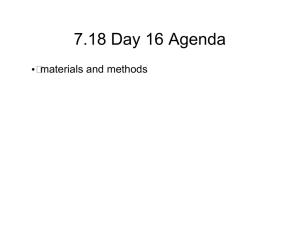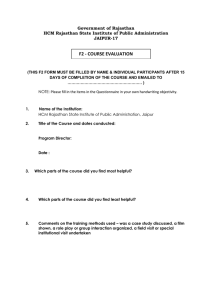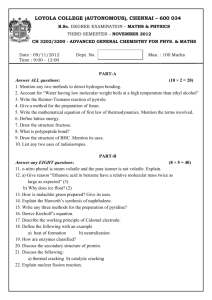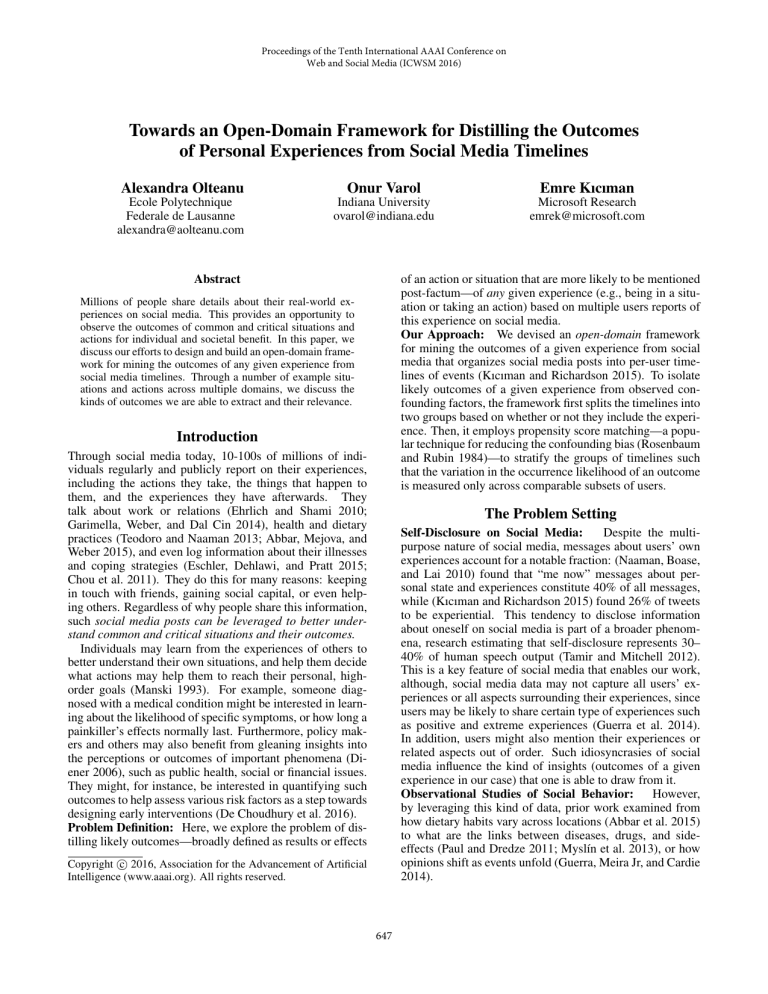
Proceedings of the Tenth International AAAI Conference on
Web and Social Media (ICWSM 2016)
Towards an Open-Domain Framework for Distilling the Outcomes
of Personal Experiences from Social Media Timelines
Alexandra Olteanu
Onur Varol
Emre Kıcıman
Ecole Polytechnique
Federale de Lausanne
alexandra@aolteanu.com
Indiana University
ovarol@indiana.edu
Microsoft Research
emrek@microsoft.com
of an action or situation that are more likely to be mentioned
post-factum—of any given experience (e.g., being in a situation or taking an action) based on multiple users reports of
this experience on social media.
Our Approach: We devised an open-domain framework
for mining the outcomes of a given experience from social
media that organizes social media posts into per-user timelines of events (Kıcıman and Richardson 2015). To isolate
likely outcomes of a given experience from observed confounding factors, the framework first splits the timelines into
two groups based on whether or not they include the experience. Then, it employs propensity score matching—a popular technique for reducing the confounding bias (Rosenbaum
and Rubin 1984)—to stratify the groups of timelines such
that the variation in the occurrence likelihood of an outcome
is measured only across comparable subsets of users.
Abstract
Millions of people share details about their real-world experiences on social media. This provides an opportunity to
observe the outcomes of common and critical situations and
actions for individual and societal benefit. In this paper, we
discuss our efforts to design and build an open-domain framework for mining the outcomes of any given experience from
social media timelines. Through a number of example situations and actions across multiple domains, we discuss the
kinds of outcomes we are able to extract and their relevance.
Introduction
Through social media today, 10-100s of millions of individuals regularly and publicly report on their experiences,
including the actions they take, the things that happen to
them, and the experiences they have afterwards. They
talk about work or relations (Ehrlich and Shami 2010;
Garimella, Weber, and Dal Cin 2014), health and dietary
practices (Teodoro and Naaman 2013; Abbar, Mejova, and
Weber 2015), and even log information about their illnesses
and coping strategies (Eschler, Dehlawi, and Pratt 2015;
Chou et al. 2011). They do this for many reasons: keeping
in touch with friends, gaining social capital, or even helping others. Regardless of why people share this information,
such social media posts can be leveraged to better understand common and critical situations and their outcomes.
Individuals may learn from the experiences of others to
better understand their own situations, and help them decide
what actions may help them to reach their personal, highorder goals (Manski 1993). For example, someone diagnosed with a medical condition might be interested in learning about the likelihood of specific symptoms, or how long a
painkiller’s effects normally last. Furthermore, policy makers and others may also benefit from gleaning insights into
the perceptions or outcomes of important phenomena (Diener 2006), such as public health, social or financial issues.
They might, for instance, be interested in quantifying such
outcomes to help assess various risk factors as a step towards
designing early interventions (De Choudhury et al. 2016).
Problem Definition: Here, we explore the problem of distilling likely outcomes—broadly defined as results or effects
The Problem Setting
Self-Disclosure on Social Media:
Despite the multipurpose nature of social media, messages about users’ own
experiences account for a notable fraction: (Naaman, Boase,
and Lai 2010) found that “me now” messages about personal state and experiences constitute 40% of all messages,
while (Kıcıman and Richardson 2015) found 26% of tweets
to be experiential. This tendency to disclose information
about oneself on social media is part of a broader phenomena, research estimating that self-disclosure represents 30–
40% of human speech output (Tamir and Mitchell 2012).
This is a key feature of social media that enables our work,
although, social media data may not capture all users’ experiences or all aspects surrounding their experiences, since
users may be likely to share certain type of experiences such
as positive and extreme experiences (Guerra et al. 2014).
In addition, users might also mention their experiences or
related aspects out of order. Such idiosyncrasies of social
media influence the kind of insights (outcomes of a given
experience in our case) that one is able to draw from it.
Observational Studies of Social Behavior:
However,
by leveraging this kind of data, prior work examined from
how dietary habits vary across locations (Abbar et al. 2015)
to what are the links between diseases, drugs, and sideeffects (Paul and Dredze 2011; Myslı́n et al. 2013), or how
opinions shift as events unfold (Guerra, Meira Jr, and Cardie
2014).
c 2016, Association for the Advancement of Artificial
Copyright Intelligence (www.aaai.org). All rights reserved.
647
Controlling for Confounding Bias: Yet, although controlling for confounding bias in observational studies on social media is important (Gayo-Avello 2011), this is rare:
many analyses are only co-occurrence based, assuming that
co-occurring items share some true relation. A key challenge is discriminating attributes that are merely correlated
with a variable of interest from those causally related to it.
This is due to subjects not being randomly assigned to the
groups under study, making them prone to the correlationcausation fallacy. Recent social media studies looking at
shifts in suicidal ideation (De Choudhury et al. 2016), at the
effect of exercise on mental health (Dos Reis and Culotta
2015), or of community feedback on individual user behavior (Cheng et al. 2014) try to fill this gap by applying techniques that have come into extensive use in medicine, economics, and other sciences, including the potential outcomes
framework of the Rubin causal model (Sekhon 2007) and
the structural equation model (Robins and Wasserman 1999;
Pearl 2000). To complement these efforts, we aim to develop
generalizable techniques that separate the domain-agnostic
mechanics of such analyses from the semantic interpretation
of results that often requires domain knowledge.
Most similar to our work is the study of (Landeiro and Culotta 2016) that focuses on adjusting for confounding factors
in social media text classification. While their study considers a socioeconomic confounding variable (gender), we take
into account all terms used in the past by users. While these
terms are unlikely to capture all variables correlated with
the confounding variables (as it is hard to argue that all relevant aspects of users’ lives are captured in their social media
streams), word use is known, for instance, to correlate with
various psyho-socio-economic factors including gender, age
or personality (Schwartz et al. 2013). In addition, rather than
classifying users based on the prevalence of outcomes, our
goal is to uncover likely outcomes of any experience.
the experience across user timelines, which we use to compute the propensity to mention the experience, respectively
to locate potential outcomes after the experience took place.
Outcomes Extraction & Treatment Effect: The goal of
our analysis is to understand whether a user mention of the
experience makes her more or less likely to mention certain
events in the future, for which we employ propensity score
matching (Rosenbaum and Rubin 1984). To isolate the outcomes of the experience from observed confounds—to the
degree this is possible—we wish to compare the group of
users identified to have had the experience (the treatment
group) with another set of users that share a similar distribution of features, but did not had the experience (the control group). One way to identify such comparable groups is
through matching based on users’ propensity to mention the
experience, which we estimate using the past events in the
users’ timelines. In our study, the control group is drawn
from users identified to have had a different experience, but
in the same domain (e.g. we compare users suffering from
gout, with users suffering from other diseases such as having kidney stones). Then, the two groups (treatment and control) are subdivided based on the users propensity to mention
the experience into comparable sub-groups. To determine
the effects of the target experience we iteratively examining
each post-hoc event (possible outcome) reported by users for
systematic differences in the event likelihood among comparable treatment and control subgroups. Finally, we report the
average treatment effect for each event across subgroups.
Exploratory Analysis
To assess our framework, we examined a variety of experiences about which people actively seek information to make
decisions (including health ailments, business and financial
decisions, relationship issues), and gathered 3 months of
tweets for users that mentioned them within the time frame
of one month (varying from 10s to 50k users per experience).
We first review the raw results generated by our framework.
Table 1 shows the top-most statistically significant outcomes
extracted for a sample of experiences. We can see that the
extracted outcomes are topically related to the target experience: users discussing gout are significantly more likely to
mention flare ups of their symptoms, uric acid, and the physical locations of their symptoms, while users mentioning
high triglyceride levels later discuss statins, cardiovascular
issues, and dietary changes. Similarly, we see topically relevant outcomes for other scenarios (e.g., investment-related
words such as the stock market, or varieties of anxieties and
manifestations such as panic attacks).
Then, we looked at the temporal evolution of outcomes
which provides additional context for characterizing the outcomes of an experience. Figure 1 highlights several of examples. We observe, for instance, that the likelihood of someone mentioning their depression increases around when she
admits to tak[ing] Prozac, with other outcomes following a
similar pattern such as get paid when increasing the gross
income. In other cases, the outcomes become prominent
several days later, like discussing medication when taking
Lorazepam or joint when suffering from gout (known to lead
to swelling joints). Other outcomes are more likely to occur
A Framework for Outcomes Extraction
In this section, we briefly cover the key aspects of our
pipeline for extracting likely outcomes of a target experience
from a large corpus of social media messages:
Identifying Treated Users: The first challenge is to identify social media users that had a given experience. To do
so, we search for a set of queries that include a conjunction
of phrases written to avoid possible ambiguity in the experience term, and that match with reasonable accuracy posts
of users that have had the experience, as opposed to using
the word in different contexts. To take a concrete example,
for prescribe drugs, we wish to avoid including advertisement tweets like “buy Xanax online”, and instead search for
specific phrases such as “I took Xanax”.
Timeliness Construction: Next, for each user we identify
this way, we retrieve their social media messages, which we
represent as lists of arbitrarily sorted unigrams and bigrams
(that we refer to as events), and use their timestamp to organize them in a per-user timeline. We then summarize the
timeline using two partial timelines tracking the first, resp.
the last, occurrence of each event. We do so to efficiently locate the set of events that have occurred before, resp. after,
648
Outcome
Count Effect% Z-Score
Health/Diseases: Gout
flare up
35
4.1
12.33
27
2.9
10.36
uric acid
28
2.9
10.11
uric
81
4.9
9.92
flare
38
2.9
9.86
big toe
joint
301
7.2
7.22
32
1.7
6.51
aged
correlation
45
2.8
6.11
53
2.5
5.96
bollock
shite
108
3.4
5.93
Outcome
Count Effect% Z-Score
Society/Issues: Belly fat
burn
156
62.2
8.96
ab workout
13
8.5
5.82
workout lose
13
8.5
5.82
help burn
8
11.1
5.82
add video
26
14.0
5.75
url playlist
26
14.0
5.75
fitness
39
18.6
5.51
ab
43
19.1
5.51
playlist mention
30
15.3
5.39
biceps
7
4.7
4.74
Outcome
Count Effect% Z-Score
Health/Diseases: Triglycerides
your risk
46
24.8
18.12
statin
48
23.1
17.69
lower
120
35.9
17.18
cardiovascular
54
23.0
16.72
healthy diet
55
19.3
16.54
fatty acid
29
18.3
16.37
help prevent
73
26.9
16.01
risk factor
33
18.3
15.55
fish oil
48
24.4
15.42
inflammation
78
25.1
15.30
Table 1: Most significant 10 outcomes following selected events. We see that individuals mentioning gout are more likely to
later mention symptoms of the disease and its cause; those mentioning high triglycerides are more likely to mention treatments;
and individuals mentioning a desire to lose “belly fat” later mention workouts, videos and music.
ally more likely to cover causal relations, including implementation steps, motivations and prerequisites, and implications. In contrast, our results do not cover as well more
conceptual and descriptive relationships, including things
that cannot be done, and alternate names and similar actions. These results indicate that our framework can distill
outcomes that share a mixture of relations with the target
experience. Note that different relation types might be of
interest to different stakeholders. For instance, an individual diagnosed with anxiety might be interested in learning
about likely, yet not desired, symptoms (e.g., panic attacks
or a nervous breakdown), while someone diagnosed with
gout might be want to know that this is related to high levels
of uric acid and his joints may be affected as a result. On
the other hand, a policy-maker might rather be interested in
learning about real-world use cases for various drugs—e.g.,
our results for Xanax indicate that while this drug is typically used for medicinal treatment of anxiety, others mention smoking weed and getting drunk around the time they
take Xanax, indicating recreational usage.
Figure 1: Comparison of temporal evolution of outcomes
in treatment (red) and control groups (blue). The volume
indicates the expected number of tweets per user (max value
highlighted). Best seen in color.
Future Directions
both with the target event, as well as a few days later, e.g.,
the use of weed after taking Xanax (also taken for recreational use). We also notice interesting interplays among
outcomes of the same experience: we see the mention of
painkiller peaking around the time users mention taking Tramadol, while pain seems to recur again after a week.
Our analysis aims to distill the outcomes that are more likely
to be mentioned on social media following personal experiences. However, it remains to be seen how relevant these
outcomes are across domains and for various tasks. Thus,
our future work would naturally include a more comprehensive assessment of our framework, including an evaluation
procedure to judge the relevancy and the quality of our results, an analysis of the relationship between the data volume (e.g., number of users, of tweets, timeline length) and
the results quality, but also a more detailed characterization
of the kinds of outcomes we extract.
Another important area that needs to be explored in the
future, is the question of how the information about the outcomes can best be used and presented to aid people in specific application scenarios, as well as, the implications of
these application patterns for the analysis framework itself.
What Kinds of Outcome Are Found?
To better understand the kinds of outcomes extracted by
our framework, and whether these outcomes are conceptually or causally related to the target experience, we contrast our frameworks results with available concepts and relations from a large knowledge base, ConceptNet5 (Speer
and Havasi 2012). In ConceptNet5, the relations between
concepts are categorized across a variety of types, capturing
both conceptual and descriptive relations, e.g., IsA, DerivedFrom or SimilarTo, as well as more causal like relations, e.g.,
Causes, HasSubEvent or MotivatedByGoal. Example relations include [xanax IsA prescription drug], [xanax UsedFor
anxiety] and [divorce CausesDesire drink].
Across all domains, we find that our results are gener-
Concluding Remarks
Social media, sensors and other computing services capture increasing amounts of data about the behaviors and ex-
649
periences of millions of people. This provides an opportunity to better understand common and critical situations
people are in, the actions they take, and their implications.
Our aim is to develop generalizable techniques that separate the domain-agnostic mechanics of such analysis from
the semantic interpretation of results that often requires domain knowledge. Driven by the type of experiences and domains about which people actively seek information online,
our evaluation demonstrates that our framework may support people interested in gleaning insights into phenomena
across a wide variety of semantic domains.
Applications for Individuals: We believe that individuals
may benefit from the kind of outcomes we uncover. People
planning their retirement might be interested in knowing that
others having a pension tend to also be concerned with taxes,
benefits or health care. Even when the outcomes of an action or situation are known, aggregated statistics about their
likelihood can prove informative for those seeking information about them: someone taking Prozac to treat a depressive episode might feel relieved to know that while the likelihood of mentioning depression is high among others taking Prozac, the incidence of these mentions tends to quickly
fade away after the treatment starts.
Applications for Policy-makers & Others: Further, while
our work is motivated primarily by the desire to help individuals understand their situations and possible implications of their actions, there is also an opportunity to use this
kind of analysis to better understand behavioral phenomena
of societal importance, third-party interventions and other
policy questions. For instance, learning about the concerns
(and their likelihood) of people having a pension within a
given time period is not only informative for individuals,
but it is also an important source of information for policymakers (Diener 2006). Other example, for pharmaceutical
and public health research, such a source of information can
help understanding drug uses that fall beyond the drug prescription (as we have found about Xanax).
Limitations: Our analysis aims to distill the outcomes that
are more likely to be mentioned following personal experiences. However, it is important to note that while we borrow propensity score analysis from the causal inference literature, this application is not causal due to key assumptions that fail to hold. Furthermore, our analysis currently
ignores population and reporting biases of social media. Future work includes scalability and performance of the analysis, as well as visualization and applications.
Diener, E. 2006. Guidelines for national indicators of subjective
well-being and ill-being. Applied Research in Quality of Life.
Dos Reis, V. L., and Culotta, A. 2015. Using matched samples
to estimate the effects of exercise on mental health via twitter. In
AAAI.
Ehrlich, K., and Shami, N. S. 2010. Microblogging inside and
outside the workplace. In ICWSM.
Eschler, J.; Dehlawi, Z.; and Pratt, W. 2015. Self-characterized
illness phase and information needs of participants in an online
cancer forum. In ICWSM.
Garimella, V. R. K.; Weber, I.; and Dal Cin, S. 2014. From ”i love
you babe” to ”leave me alone”-romantic relationship breakups on
Twitter. In SocInfo.
Gayo-Avello, D. 2011. Don’t turn social media into another ’Literary Digest’ poll. Communications of the ACM.
Guerra, P. C.; Meira Jr, W.; and Cardie, C. 2014. Sentiment analysis on evolving social streams: How self-report imbalances can
help. In WSDM.
Kıcıman, E., and Richardson, M. 2015. Towards decision support and goal achievement: Identifying action-outcome relationships from social media. In KDD.
Landeiro, V., and Culotta, A. 2016. Robust text classification in
the presence of confounding bias. In AAAI.
Manski, C. F. 1993. Dynamic choice in social settings: Learning
from the experiences of others. Journal of Econometrics.
Myslı́n, M.; Zhu, S.-H.; Chapman, W.; and Conway, M. 2013. Using twitter to examine smoking behavior and perceptions of emerging tobacco products. Journal of medical Internet research 15(8).
Naaman, M.; Boase, J.; and Lai, C.-H. 2010. Is it really about me?:
message content in social awareness streams. In CSCW. ACM.
Paul, M. J., and Dredze, M. 2011. You are what you tweet: Analyzing twitter for public health. In ICWSM, 265–272.
Pearl, J. 2000. Causality: models, reasoning and inference, volume 29. Cambridge Univ Press.
Robins, J. M., and Wasserman, L. 1999. On the impossibility of inferring causation from association without background knowledge.
Computation, causation, and discovery 305–321.
Rosenbaum, P. R., and Rubin, D. B. 1984. Reducing bias in observational studies using subclassification on the propensity score.
Journal of the American Stat. Assoc. 79(387):516–524.
Schwartz, H. A.; Eichstaedt, J. C.; Kern, M. L.; Dziurzynski, L.;
Ramones, S. M.; Agrawal, M.; Shah, A.; Kosinski, M.; Stillwell,
D.; Seligman, M. E.; et al. 2013. Personality, gender, and age in
the language of social media: The open-vocabulary approach. PloS
one.
Sekhon, J. S. 2007. The neyman-rubin model of causal inference
and estimation via matching methods. In Oxford handbook of political methodology.
Speer, R., and Havasi, C. 2012. Representing general relational
knowledge in ConceptNet 5. In LREC, 3679–3686.
Tamir, D. I., and Mitchell, J. P. 2012. Disclosing information about
the self is intrinsically rewarding. National Academy of Sciences.
Teodoro, R., and Naaman, M. 2013. Fitter with Twitter: Understanding personal health and fitness activity in social media. In
ICWSM.
References
Abbar, S.; Mejova, Y.; and Weber, I. 2015. You tweet what you
eat: Studying food consumption through Twitter. In CHI.
Cheng, J.; Danescu-Niculescu-Mizil, C.; and Leskovec, J. 2014.
How community feedback shapes user behavior. In ICWSM.
Chou, W.-Y. S.; Hunt, Y.; Folkers, A.; and Augustson, E. 2011.
Cancer survivorship in the age of YouTube and social media: a
narrative analysis. Journal of medical Internet research 13(1).
De Choudhury, M.; Kiciman, E.; Dredze, M.; Coppersmith, G.;
and Kumar, M. 2016. Discovering shifts to suicidal ideation from
mental health content in social media. In CHI.
650

